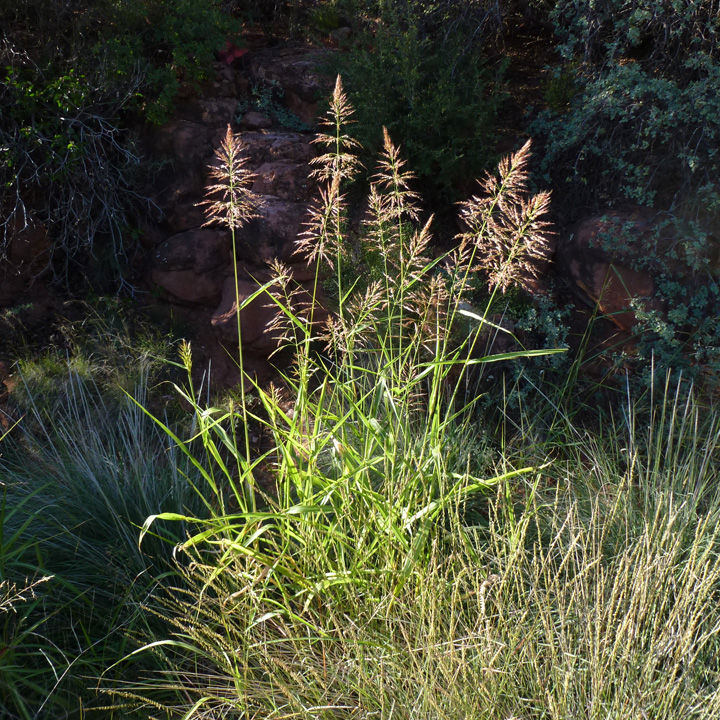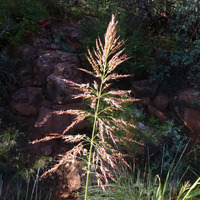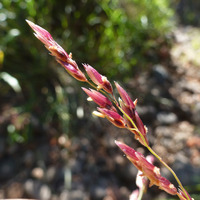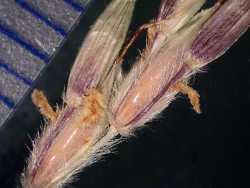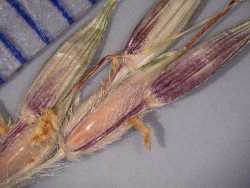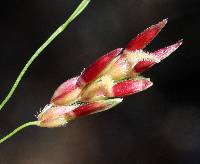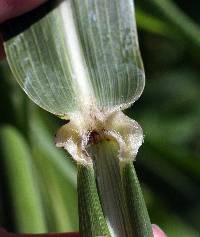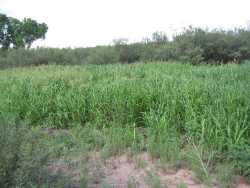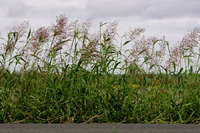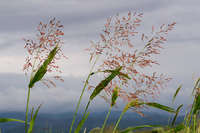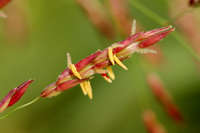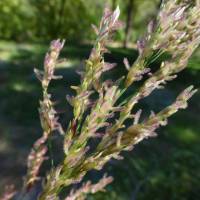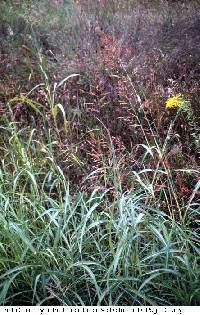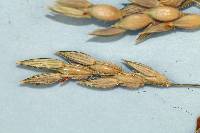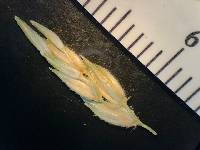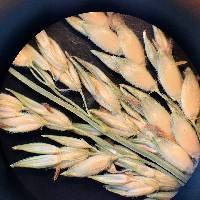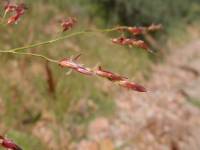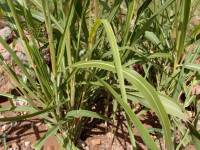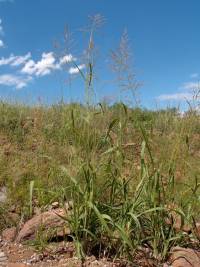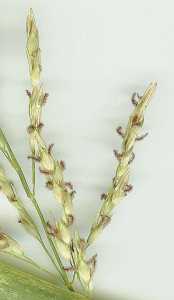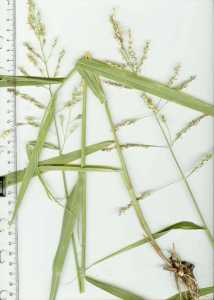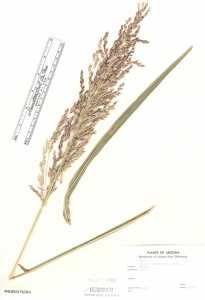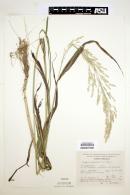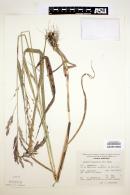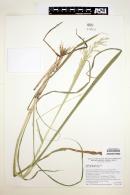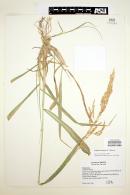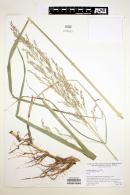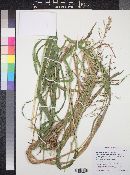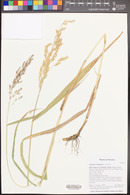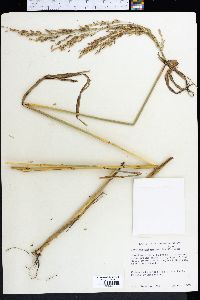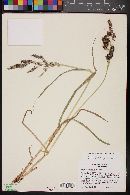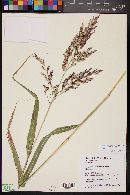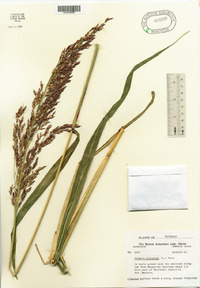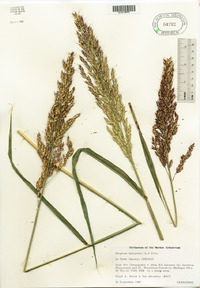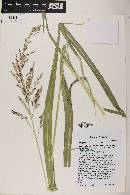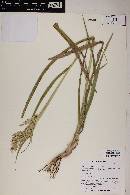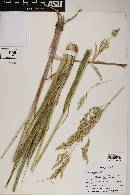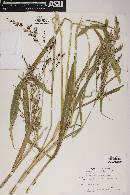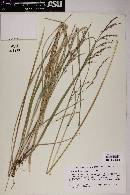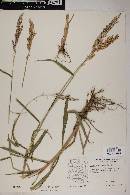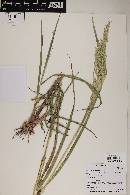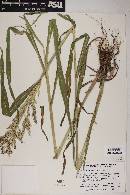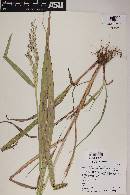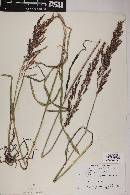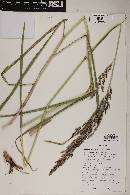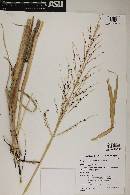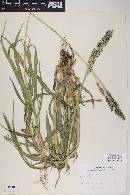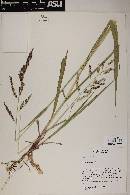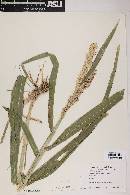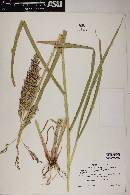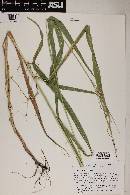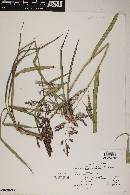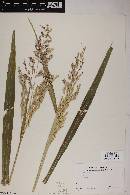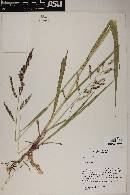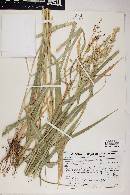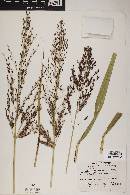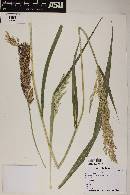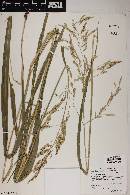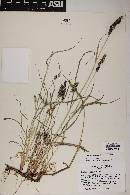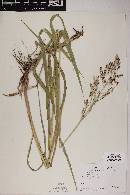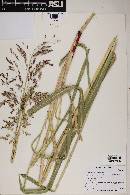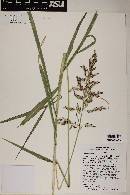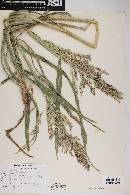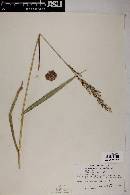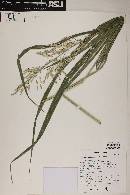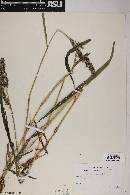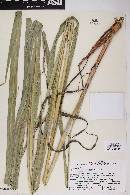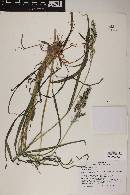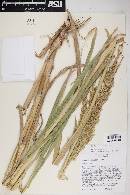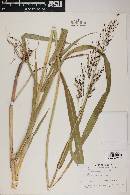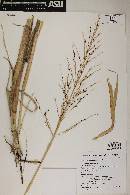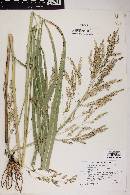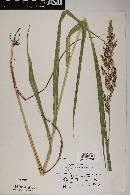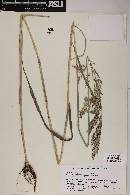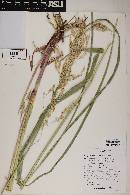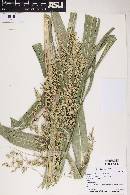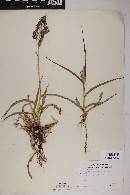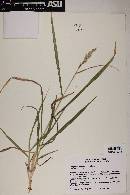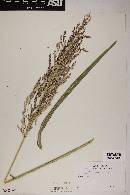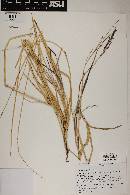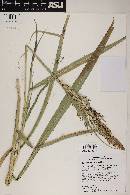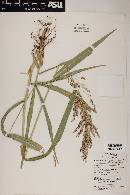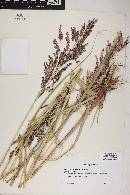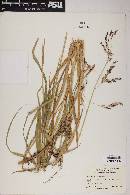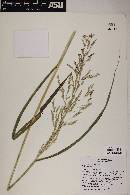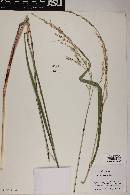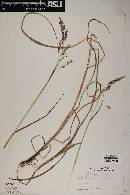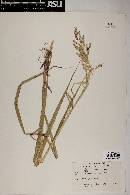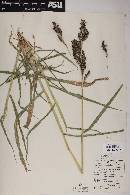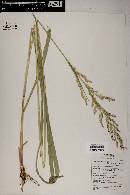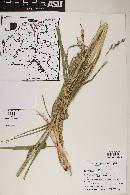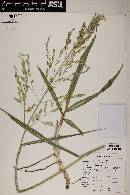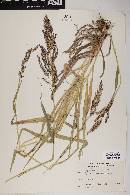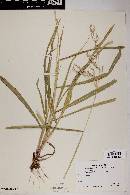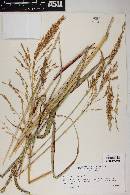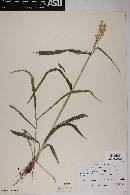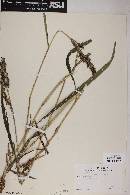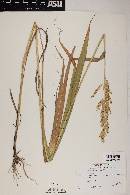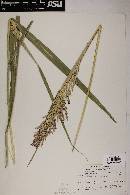Sorghum halepense
|
|
|
|
Family: Poaceae
Johnson Grass, more...aleppo milletgrass, herbe de Cuba, sorgho d'Alep, sorgo de alepo, zacate Johnson (es: zacate johnson, zacate nilo)
[Andropogon controversus Steud., moreAndropogon halepensis , Andropogon halepensis subsp. anatherus Piper, Andropogon halepensis var. genuinus Stapf, Andropogon halepensis var. muticus (Hack.) Asch. & Graebn., Andropogon miliaceus Roxb., Andropogon sorghum subsp. halepensis (L.) Hack., Andropogon sorghum var. corymbosus Hack., Andropogon sorghum var. halepensis (L.) Hack., Andropogon sorghum var. perennis Bertoni, Blumenbachia halepensis (L.) Koeler, Holcus halepensis L., Milium halepense (L.) Cav., Rhaphis halepensis (L.) Roberty, Sorghum controversum (Steud.) Snowden, Sorghum halepense f. halepense (L.) Pers., Sorghum halepense f. muticum (Hack.) C.E. Hubb., Sorghum halepense var. genuinum Hack., Sorghum halepense var. halepense (L.) Pers., Sorghum halepense var. muticum (Hack.) Hayek, Sorghum miliaceum (Roxb.) Snowden, Sorghum saccharatum var. halapense (L.) Kuntze, Sorgum halepense (L.) Pers., Trachypogon avenaceus Nees] |
Plants perennial; rhizomatous. Culms 50-200 cm tall, 0.4-2 cm thick; nodes appressed pubescent; internodes glabrous. Ligules 2-6 mm, membranous, conspicuously ciliate; blades 10-90 cm long, 8-40 mm wide. Panicles 10-50 cm long, 5-25 cm wide, primary branches compound, terminating in rames of 1-5 spikelet pairs; disarticulation usually beneath the sessile spikelets, sometimes also beneath the pedicellate spikelets. Sessile spikelets bisexual, 3.8-6.5 mm long, 1.5-2.3 mm wide; calluses blunt; glumes indurate, shiny, appressed pubescent; upper lemmas unawned, or with a geniculate, twisted awn to 13 mm; anthers 1.9-2.7 mm. Pedicels 1.8-3.3 mm. Pedicellate spikelets staminate, 3.6-5.6 mm; glumes membranous to coriaceous, unawned. Caryopses not exposed at maturity. 2n = 20, 40; several dysploid counts also reported. Sorghum halepense is native to the Mediterranean region. It is sometimes grown for forage in North America, but it is considered a serious weed in warmer parts of the United States. It hybridizes readily with S. bicolor, and derivatives of such hybrids are widespread. The annual Sorghum almum Parodi, which has wider (2-2.8 mm) sessile spikelets with more veins in the lower glumes (13-15 versus 10-13) than S. halepense, is one such derivative. Perennial rhizome-bearing herb 0.5 - 2.5 m tall Leaves: basal and along culm, with ligules that are 2 - 6 mm long, membranous, and lined with hairs along the margins. Blades are 10 cm - 0.9 m long and 8 - 40 mm wide. Inflorescence: terminal, branched (panicle), 10 - 50 cm long, 5 - 25 cm wide. Primary branches are whorled and end in spikes with one to five spikelet pairs. Fruit: a caryopsis that is not exposed when mature. Culm: 0.5 - 2 m long, 0.4 - 2 cm across, with appressed-hairy nodes and hairless internodes. Spikelets: either stalkless or stalked. The stalkless spikelets are bisexual, 3.8 - 6.5 mm long, 1.5 - 2.3 mm wide, and compressed on the back. Stalked spikelets male, well-developed, 3.6 - 5.6 mm long. Glumes: of stalkless spikelets shiny, hardened, and appressed-hairy, the lower glume compressed on the back and rounded near the base, the upper glume with two longitudinal ridges. Glumes of the stalked spikelets are membranous to leather-like. Florets: borne on stalkless spikelets have lower florets reduced to transparent lemmas, upper florets with anthers 1.9 - 2.7 mm long and transparent lemmas that are unawned or have a bent and twisted awn to 13 mm long. Similar species: Sorghum bicolor is an annual or short-lived perennial that lacks rhizomes and often has exposed mature caryopses. Flowering: early July to late September Habitat and ecology: Introduced from the Mediterranean, this species grows near grain elevators and in sandy road shoulders after a recent seeding (likely being in the seed mix). This species is a problem weed in the south, but is most likely not cold hardy here. Occurence in the Chicago region: non-native Etymology: Sorghum comes from the plant's Italian name, sorgo. Halepense means "from Aleppo, Syria." Author: The Morton Arboretum FNA 2007, Gould 1980, Heil et al 2013, USDA GRIN, USDA FEIS, Jordan 2008, Hussain et al 2008 Common Name: Johnsongrass Duration: Perennial Nativity: Non-Native Lifeform: Graminoid General: Large perennial grass from stout, scaly rhizomes, stems 1-2 m tall, stem nodes glabrous or finely pubescent. Vegetative: Sheaths glabrous, puberulent across the collar; ligules membranous, truncate, ciliate 1.5-3 mm long; blades large, flat, 4-15 mm broad, 20-50 cm long, margins white, midvein white and prominent. Inflorescence: Panicle usually large, densely flowered, variable, mostly 15-35 cm long; spikelets and pedicels more or less hirsute; As is characteristic of the the grass tribe Andropogonae, S. halepense has spikelets arranged in pairs: one spikelet is sessile and bisexual and the other is pedicelled and staminate. In this species, disarticulation is usually beneath the sessile spikelets, but sometimes also beneath the pedicellate spikelets. Sessile spikelets are 4-6 mm long, with 2 florets, the first sterile and reduced to a hyaline lemma, and the second fertile. Glumes of sessile spikelets are subequal, broad, coreaceous; lemma of fertile floret membranous, usually with a twisted, once-geniculate awn up to 13 mm long, this readily deciduous. Pediceled spikelet staminate, awnless, lanceolate, usually about as long as the sessile one. Ecology: Common weed on moist roadsides, ditchbanks, cultivated fields, and wastelands; up to 7,000 ft (2134 m). Flowers April-November. Distribution: Native to the Mediterranean and naturalized around the world in warm-temperate regions. Found in Ontario and every state in the US, south to South America. Notes: A robust perennial grass distinguished by being rhizomotous and tall, up to 2 m; with ciliate ligules, and pyramidal, open inflorescences bearing pedicillate-sessile spikelet pairs which are hairy and have twisted awns. The entire inflorescence usually has a conspicuous reddish color. The species is considered to be highly invasive, and commonly found along irrigation ditches and in floodplains in the Southwest. Johnson grass was historically cultivated for hay and forage but is no longer recommended for planting due to its invasiveness and ability to form stable hybrids with S. bicolor (cultivated sorghum). Also, at certain developmental stages and under some adverse environmental conditions, Johnson grass may form cyanogenetic glycosides that can poison livestock. It also appears to sequester selenium and other elements that are toxic at high doses when growing in soils with high concentrations of those elements, making it potentially useful for mine reclamation. Ethnobotany: Used by the Plains Apache to make mattresses and brooms. Used medicinally in the Middle East and Pakistan. Etymology: Sorghum is from Italian sorgo, for a tall cereal grass, and halepense refers to being of or from Allepo, northern Syria. Synonyms: Holcus halapensis, Sorghum miliaceum Editor: SBuckley 2010, FSCoburn 2014, AHazelton 2015 Robust perennial to 1.5 m, colonial by long rhizomes; lvs elongate, 1-2 cm wide; panicle 1.5-4 dm, open, its main axis glabrous or scabrous; sessile spikelet silky, 4-6 mm, the pediceled one staminate (or neuter), glabrous, slightly longer; awn 1-1.5 cm; 2n=40. Native to the Mediterranean region, cult. for forage, escaped and well established as a weed especially in the s. part of our range, but also n. to Mass. and Mich. (Holcus h.; S. miliaceum) Under some conditions the plant becomes poisonous through the production of prussic acid. Johnson-grass is the result of hybridization with cult. sorghum. Gleason, Henry A. & Cronquist, Arthur J. 1991. Manual of vascular plants of northeastern United States and adjacent Canada. lxxv + 910 pp. ©The New York Botanical Garden. All rights reserved. Used by permission. From Flora of Indiana (1940) by Charles C. Deam Infrequent but spreading in the southwestern part of the state. It is found mostly along roadsides and railroads and sometimes in cultivated fields, these usually contiguous to streams or railroads. Several years ago I found it in large colonies in the cornfields of the Wabash Bottoms and landowners were not aware of its weedy nature. While this grass has forage crop value, it should be exterminated, because it is difficult to eradicate and carries the possibility of seeding adjacent areas where it is not desired. [Deam also recognizes S. vulgare var. drummondii which currently is synonymized with S. halepense. He notes that] this grass was first reported from Posey and Vanderburgh Counties in 1923. I have seen it as a common weed in the cornfields in Point Township of Posey County where it often overtopped the corn. A pioneer in that vicinity informed me that he thought it was introduced about 1890. …… Indiana Coefficient of Conservatism: C = null, non-native Wetland Indicator Status: FACU Deam (1929): This grass is native of the countries about the Mediterranean and eastward in the Himalayas. It was first introduced into the U.S. from Turkey about 1830 by Governor Means of South Carolina. In about 1840 Col. William Johnson introduced it on his plantation in Alabama. It has had several common name but the generally accepted one now is Johnson grass. In Indiana it does not seem to be widely distributed. |
|
|
|

